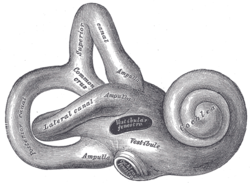Bony labyrinth
| Bony labyrinth | |
|---|---|
 Lateral view of right osseous labyrinth | |
 Interior view of right osseous labyrinth | |
| Details | |
| Identifiers | |
| Latin | Labyrinthus osseus |
| TA98 | A15.3.03.003 |
| TA2 | 692, 6936 |
| FMA | 60179 |
| Anatomical terminology | |
The bony labyrinth (also osseous labyrinth or otic capsule) is the rigid, bony outer wall of the inner ear in the temporal bone. It consists of three parts: the vestibule, semicircular canals, and cochlea. These are cavities hollowed out of the substance of the bone, and lined by periosteum. They contain a clear fluid, the perilymph, in which the membranous labyrinth is situated.
A fracture classification system in which temporal bone fractures detected on CT are delineated based on disruption of the otic capsule has been found to be predictive for complications of temporal bone trauma such as facial nerve injury, sensorineural deafness and cerebrospinal fluid otorrhea. On radiographic images, the otic capsule is the most dense portion of the temporal bone.[1][2]
In otospongiosis, a leading cause of adult-onset hearing loss, the otic capsule is exclusively affected. This area normally undergoes no remodeling in adult life and is extremely dense. With otospongiosis, the normally dense enchondral bone is replaced by haversian bone, a spongy and vascular matrix that results in sensorineural hearing loss due to compromise of the conductive capacity of the inner ear ossicles. This results in hypodensity on CT, with the portion first affected usually being the fissula ante fenestram.[3]
The bony labyrinth is studied in Paleoanthropology as it is a good indicator for distinguishing Neanderthals and Modern humans. [4][5][6]
References[]
- ^ Little, S. C.; Kesser, B. W. (2006). "Radiographic classification of temporal bone fractures: Clinical predictability using a new system". Archives of Otolaryngology–Head & Neck Surgery. 132 (12): 1300–4. doi:10.1001/archotol.132.12.1300. PMID 17178939.
- ^ Brodie, H. A.; Thompson, T. C. (1997). "Management of complications from 820 temporal bone fractures". The American Journal of Otology. 18 (2): 188–97. PMID 9093676.
- ^ Eisenberg, Mai-Lan Ho, Ronald L. (2014). Neuroradiology signs. ISBN 9780071804325.
- ^ Hublin, Jean-Jacques; Spoor, Fred; Braun, Marc; Zonneveld, Frans; Condemi, Silvana (16 May 1996). "A late Neanderthal associated with Upper Palaeolithic artefacts". Nature. 381 (6579): 224–226. doi:10.1038/381224a0.
- ^ Coutinho-Nogueira, Dany; Coqueugniot, Hélène; Santos, Frédéric; Tillier, Anne-marie (September 2021). "The bony labyrinth of Qafzeh 25 Homo sapiens from Israel". Archaeological and Anthropological Sciences. 13 (9): 151. doi:10.1007/s12520-021-01377-2.
- ^ Spoor, Fred; Hublin, Jean-Jacques; Braun, Marc; Zonneveld, Frans (February 2003). "The bony labyrinth of Neanderthals". Journal of Human Evolution. 44 (2): 141–165. doi:10.1016/s0047-2484(02)00166-5.
![]() This article incorporates text in the public domain from page 1047 of the 20th edition of Gray's Anatomy (1918)
This article incorporates text in the public domain from page 1047 of the 20th edition of Gray's Anatomy (1918)
- Wikipedia articles incorporating text from the 20th edition of Gray's Anatomy (1918)
- Ear
